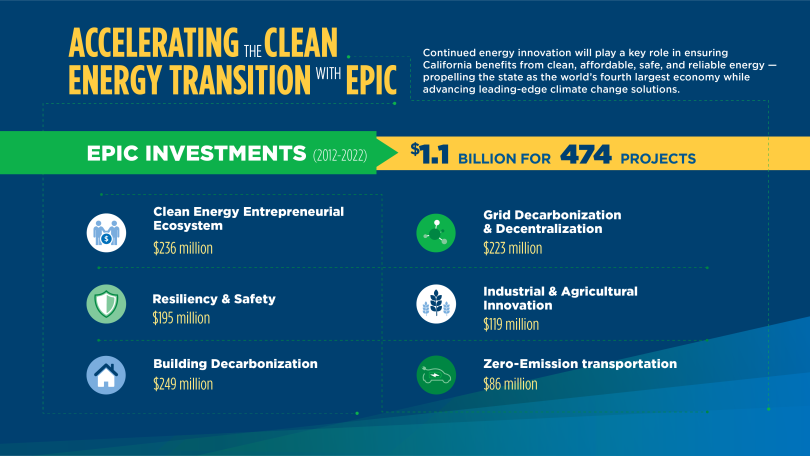For Immediate Release: May 3, 2023
A Decade After its Start, Program Continues to Advance State’s Climate Goals While Creating Jobs
SACRAMENTO – A new report shows how California’s premier public interest clean energy research and development program continues to add to its decade-long track record of advancing technologies to address the climate challenge while attracting new investment and creating jobs.
Since its creation in 2012, the California Energy Commission’s (CEC) Electric Program Investment Charge (EPIC) has invested $1.1 billion toward the state’s clean energy economy to support early-stage technologies that advance the environmental sustainability, reliability and affordability of the electric system. The program has attracted a tenfold return on investment, with awardees earning more than $10.5 billion in follow-on funding after EPIC investments.
“EPIC remains more critical than ever in bringing cutting-edge clean energy solutions to the market and setting an example of successful public-private partnership,” said CEC Chair David Hochschild. “While much work and increasingly difficult challenges remain, programs like EPIC that harness the innovative spirit of Californians are continuing to chart the path forward for all.”
In the past decade:
- The EPIC program funded more than 470 projects in nearly every sector of California’s clean energy economy.
- Investments resulted in more than 70 technologies commercialized.
- Companies in the program portfolio raised more than $10.5 billion in private investments and saw 21 percent employment growth.
- Seventy percent of demonstration and deployment funds have been invested in underresourced communities, including $22 million benefitting California Native American Tribes.
The report features profiles of EPIC-funded innovations including:
- Marine Corps Air Station Miramar’s microgrid that provided back-up electricity during the September 2022 heat wave helping to improve grid resiliency.
- A wildfire forecasting tool and climate change projection modeler that delivers more timely, granular, and accurate results.
- A nontoxic liquefied gas electrolyte that improves the safety of lithium-ion batteries by reducing fire risk and delivers improved energy density.
- Repurposed electric vehicle batteries for energy storage to provide back-up power for commercial buildings while reducing battery waste.
- Off-the-shelf window-mounted heat pump technology that can be installed by a customer in most residential spaces saving money and greenhouse gas emissions.
Strengthening Federal Partnerships
Last year also saw the Biden administration sign the Infrastructure Investment and Jobs Act and the Inflation Reduction Act into law, providing the most significant infusion of public dollars and incentives for clean energy in the nation in more than a decade.
To maximize the effectiveness of government-sponsored research and development, the CEC has this week re-established an agreement with its federal counterpart, the U.S. Department of Energy’s Advanced Research Projects Agency-Energy (ARPA-E) program.
Like EPIC, ARPA-E advances high-potential, high-impact energy technologies that are too early for private-sector investment by providing researchers with funding, technical assistance and market readiness.
“CEC and ARPA-E have long supported transformational energy innovation, and we have shared goals to enhance the economic and energy security of California and our entire nation,” said ARPA-E Director Evelyn N. Wang. “This collaboration will accelerate our critical work to research, develop, demonstrate, and ultimately deploy energy technologies.”
Through coordinated funding and information sharing, the partnership has resulted in more than $160 million in funding to more than 30 California companies, attracted more than $1.7 billion in private investment to the state, and created more than 1,000 new jobs.
Learn more about the EPIC program and the projects it supports by viewing the 2022 EPIC Highlights.
For information on specific projects, visit the Energize Innovation Showcase.
About the California Energy Commission
The California Energy Commission is the state's primary energy policy and planning agency. It has seven core responsibilities: advancing state energy policy, encouraging energy efficiency, certifying thermal power plants, investing in energy innovation, developing renewable energy, transforming transportation, and preparing for energy emergencies.
About the Electric Program Investment Charge
The Electric Program Investment Charge (EPIC Program) is funded by California utility customers under the auspices of the California Public Utilities Commission. The EPIC program provides approximately $150 million annually to fund new research and technology innovation that benefits electric ratepayers. The EPIC program is administered by the California Energy Commission, Pacific Gas and Electric Company, Southern California Electric Company, and the San Diego Gas and Electric Company.
Newsroom
Media Contact
Media and Public Communications Office
MediaOffice@energy.ca.gov
(916) 654-4989

